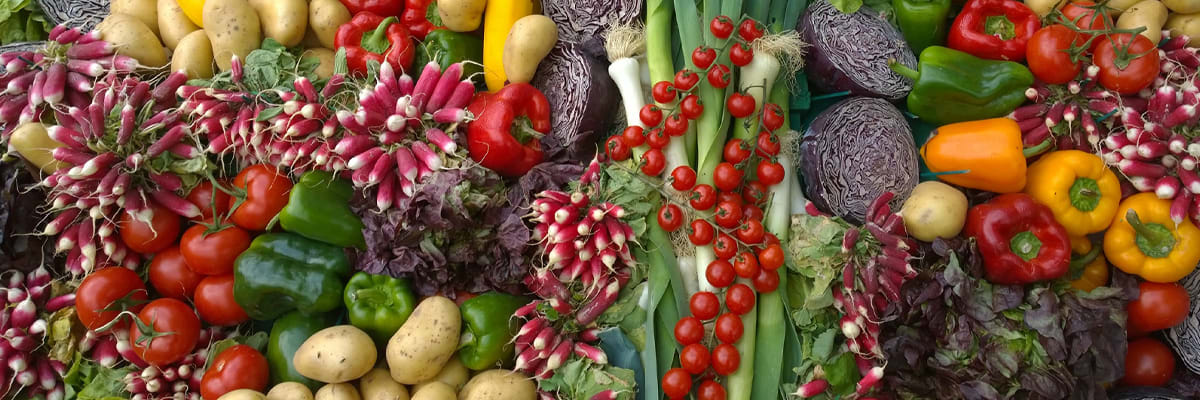5 Steps to Reducing Food Waste in the Supply Chain
More Than a Third of the World's Food Supply is Wasted Annually – Is Your Organization Helping to Reduce Food Loss?

Food waste isn’t merely a local, state, or regional concern. With over one-third of global food production wasted every year, companies and governments across the world are working to solve this challenge. Optimizing the supply chain can be an effective strategy for reducing expired food while prolonging the shelf life of your products.
Food waste does more than affect your bottom line. It disrupts your production schedule, leaving you scrambling to replace wasted products. In the event of spoilage or recall, it can make people sick and cause potentially irreversible harm to your business.
To help you reduce food waste in the supply chain, let’s take a look at temperature regulation—a major contributing factor to food waste—and five key steps you can take to improve your temperature monitoring processes.
Temperature: A Key Issue in Supply Chain Food Waste
When food isn’t stored at optimal temperatures, the quality gradually suffers until it eventually spoils. Improper temperature affects all perishables; even canned food is vulnerable to poor temperature regulation. Even when food isn’t spoiled, improper temperatures can damage your product's shelf life and quality.
Temperature control during shipping isn’t the only cause of spoilage. Gaps in the supply chain can lead to products sitting on docks, warehouses, or cold storage much longer than they should. Conditions either too warm or too cold can directly lead to quality degradation and waste. Products such as produce, flowers, ice cream, meat, and seafood are particularly affected.
For over 30 years, Sensitech has devoted itself to helping growers, producers, and suppliers optimize their cold chain and prevent food waste. By providing visibility into the supply chains with our IoT devices, you can identify gaps in the cold chain and intervene in real time.
Temperature monitoring is just the start of our optimization efforts. To get to the bottom of this issue, we must look at continuous improvements that will impact each step of the cold chain and prevent food waste.
5 Steps to Reducing Food Waste in Your Supply Chain
Every organization faces unique challenges when transporting and storing food. But everyone in the food supply chain can do their part to reduce waste by looking inward and adopting these practices.
1. Create and Follow Dynamic Best Practices
Establish guidelines and procedures for each product and shipment at every step along the supply chain. Then distribute this information to everyone who needs it; the warehouses, the shipping companies, and the retail stores. Prioritize clear and concise communication of these best practices throughout your company and facilities.
Best practices encompass a wide array of details, from proper storage temperatures to how to properly load your products into shipping vehicles and vessels. Continuously refine and improve your practices by regularly identifying at-risk segments during shipping of each journey your products make, from the point of origin to point of purchase.
Identify each step along the supply chain and investigate where and why challenges (especially those related to temperature and humidity) are most likely to occur. Respond to those challenges by first identifying a solution to the problem and then adjusting your guidelines and procedures to prevent the issue from happening. Dynamic best practices that are regularly re-evaluated help you answer those questions today and tomorrow.
2. Optimize In-Transit Temperatures
Before placing anything in a refrigerated truck, it’s important to measure the temperature of your products. Food should be loaded at a specific temperature, and no product should touch the walls of the truck.
Companies must also invest in refrigerated trucks and how well they keep products at temperature throughout transit. Obviously, trailers with built-in cooling systems are a necessity, but careful positioning of temperature monitors and the cooling systems themselves are also a must. The back of the truck is often the most difficult place to maintain temperature, so having a monitor there can alert the team should the conditions of the truck fluctuate.
Keeping trailers and cooling systems in good repair through regular monitoring and maintenance will make sure your transit vehicles aren’t having issues. Failure to do so can see a small issue balloon into a major problem that results in expensive and unnecessary food waste.
3. Optimize Storage
Storage is also another key aspect of the supply chain. It’s essential to mitigate the product's exposure to ambient air temperatures when storing food. The unloading of the truck should be done quickly to minimize temperature damage.
However, warehouses must also be managed to ensure they can keep products at the right temperature. Thermal mapping can be used to help teams determine which areas of a warehouse are at risk of temperature fluctuations. Monitors should be placed at the coldest and hottest points in any storage facility. Teams should also conduct tests to see the impact an open door or power outage has on the temperature of a warehouse or storage facility.
4. Leverage Analytics to Make Continuous Improvements
Cold chain management is not a “set it and forget it” situation. Your policies and procedures should be regularly evaluated and updated to ensure your methods are optimal. This is the only way to accurately and smoothly identify and eliminate new risks to your products.
The Internet of Things provides a nearly endless array of temperature monitoring and data recording devices, and with these, you can leverage your analytics to make assessing and updating your transportation processes as easy as possible. For example, advanced data analytics metrics can determine what the temperature of a product will be upon arrival based on various factors.
Analytics turn question marks into answers and shines a light on your blind spots. You can collect data from warehouses, storage facilities, and during transit. You can then pool that data together, creating a clear, real-time image of your supply chain.
Additionally, your team can work with experts to determine best practices to save your company money, while reducing waste. At Sensitech, each customer is assigned a program manager who can help companies interpret the data or run “what-if” scenarios. With decades of experience, our team can help improve your shipping process through data, so you can reduce waste while optimizing the supply chain.
5. Identify Weak Spots
An ongoing task for everyone in the food supply chain is figuring out where things go wrong. What makes this challenging is identifying specific causes. In some cases, multiple factors can contribute to the same problem, and solving one may lead to a cascade of additional investigations and optimizations.
With a combination of real-time temperature, analytics, and humidity tracking, you can identify where and when the cold chain breaks and take actionable steps to prevent food waste in the future.
Work With Partners You Can Trust
Food supply chain data and analytics are complex. You need a partner who understands your industry and its unique challenges. A partner who can not only create a comprehensive, real-time assessment of your entire supply chain but personally work with you to improve that supply chain and reduce food waste.
With thirty years of experience, Sensitech excels at risk ranking, risk management, and the right-for-you analytics that creates end-to-end supply chain visibility. With assigned program managers that work directly with our customers, we focus on continuous improvement through quarterly reviews, recommendations, and personalized metrics tailored to who you are and what you do.
We have a huge wealth of industry knowledge and the capacity to onboard companies big and small, creating solutions from the very advanced to the very basic. Whether you need real-time monitoring or simply best practices training and documentation, we suit our services to your needs.
To learn more on how to optimize the supply chain, sign up for our Newsletter.


